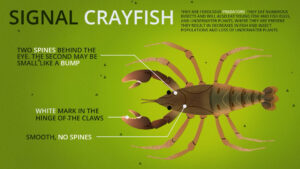Did you know there are over 50 non-native invasive species paddlers may encounter with many looking to wreak havoc across our rivers, lakes, canals and other waterways? Here are four of the most prolific villains of our waterways to give you a glimpse of some of the beasties paddlers may encounter and the devastation they can leave behind.
Killer Shrimps
Killer Shrimps are considered to be one of the most highly invasive predators to lurk in our rivers, streams and lakes. So it’s incredibly important paddlers keep their eyes peeled to help stop them from spreading any further.
Why are they so invasive? Killer Shrimps are voracious, so once they enter a new waterway they will quickly kill native invertebrates and small fish, altering the ecology of habitats found there. They live for about one year and are fast breeders which makes it difficult to control a colony once they’ve established a foothold leaving native species and habits with little chance of surviving. Did you know a killer shrimp can survive for up to 16 days in damp paddling equipment and clothing?
Where are they found? In still or slow following water often among hard surfaces and vegetation.
Floating Pennywort
Floating Pennywort is a highly invasive non-native plant that can clog up an entire waterway in just a few weeks. The threat of Floating Pennywort is becoming increasingly concerning so it is imperative paddlers play their part in thoroughly cleaning and drying equipment after every outing.
Why is it so invasive? Floating Pennywort can quickly dominate a waterway due to being able to grow up to 20cm per day. If left to spread then Floating Pennywort will create a dense mat across the waterway causing swamping, blockages, and crowding out native plants. These dense mats starve the oxygen levels, choking the life out of fish and invertebrates.
Where is it found? Lakes, canals, rivers and other waterways.
Signal Crayfish
Signal Crayfish is a menace found throughout England, causing significant problems to our waterways and posing a significant threat to native species, including the UK’s native white-clawed crayfish. Paddlers can help to report any sightings of Signal Crayfish as well as to thoroughly check your craft and equipment whilst cleaning it.
Why are they so invasive? Signal Crayfish are incredibly invasive due to their voracious appetite to eat almost anything, including aquatic plants, invertebrates and fish. They also love to burrow into the canal and river banks are also causing extensive erosion problems throughout the UK. Signal Crayfish also reproduce in great numbers meaning waterways become invested quickly and for a long period. Did you know a female can lay between 200-400 eggs and can live for up to 20 years?
Where are they found? Canals and rivers.
Giant Hogweed
Giant Hogweed is a highly invasive non-native plant that can be found by the water’s edge, along footpaths and towpaths. This non-native plant doesn’t only pose a threat to the environment but also our health. Paddlers need to be very careful and avoid brushing against or touching as it is highly poisonous. Its toxic sap can cause severe burns. Luckily, it’s quite easy to identify as it looks like giant cow parsley, with bristly stems and purple blotches. If you spot Giant Hogweed it is important to report your sighting as soon as possible so that it can be carefully removed.
Why are they so invasive? Giant Hogweed can rapidly spread as the flower heads can produce up to 50,000 seeds. These seeds are easily dispersed downstream or in areas with surface flow caused by the wind. It also has the immense ability to outcompete native vegetation leaving a devastating impact on the ecology along the banks of our waterways. Throughout, the winter months leave the banks exposed to erosion increasing the likelihood of flooding. Did you know Giant Hogweed can reach heights of up to five metres?
Where are they found? Found by the water’s edge along footpaths, towpaths and launching points.
Unfortunately, these are just four of over 50 invasive non-native species that paddlers may encounter in our lakes, waterways. Luckily, there are a few simple steps paddlers can take to help stop these invasive non-native species from hitching a piggyback ride to their next waterway.
Click here to find out how to clean your kayak, paddle board or canoe to stop the spread!






 Go Paddling
Go Paddling Clear Access Clear Waters
Clear Access Clear Waters Paddles Up Training
Paddles Up Training Clubhouse
Clubhouse Services Login
Services Login

